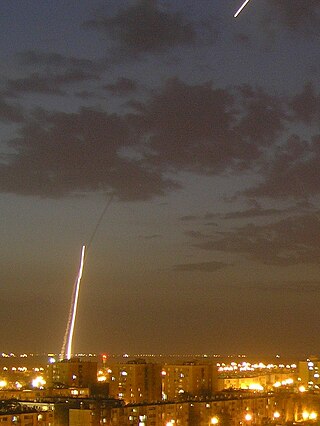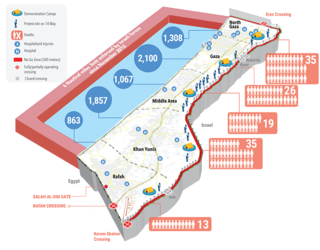
The Gaza Strip, or simply Gaza, is the smaller of the two Palestinian territories. Situated on the eastern coast of the Mediterranean Sea, Gaza is bordered by Egypt on the southwest and Israel on the east and north.

The Gaza–Israel barrier is a border barrier located on the Israeli side of the Gaza–Israel border. The Erez Crossing, in the north of the Gaza Strip, is the only crossing point for people and goods coming from Israel into the Gaza Strip; there exists a second crossing point in the barrier, called the Kerem Shalom border crossing, which is exclusive for the crossing of goods coming from Egypt, as Israel does not allow goods to go directly from Egypt into Gaza through the Egypt–Gaza border.

The 2006 Gaza–Israel conflict, known in Israel as Operation Summer Rains, was a series of battles between Palestinian militants and the Israel Defense Forces (IDF) during summer 2006, prompted by the capture of Israeli soldier Gilad Shalit by Palestinian militants on 25 June 2006. Large-scale conventional warfare occurred in the Gaza Strip, starting on 28 June 2006, which was the first major ground operation in the Gaza Strip since Israel's unilateral disengagement plan was implemented between August and September 2005.

The Erez Crossing, also known as the Beit Hanoun Crossing, is a border crossing between the Gaza Strip and Israel. It is located at the northern end of the Gaza Strip, between the Israeli kibbutz of Erez and the Palestinian town of Beit Hanoun.

The Gaza–Israel conflict is a localized part of the Israeli–Palestinian conflict. The conflict originated with the Israeli withdrawal from Gaza in 2005. Following the withdrawal, Hamas won the 2006 Palestinian legislative election, and a civil war between Hamas and Fatah in 2007 culminated in Hamas gaining control over Gaza. In response to Hamas's takeover, Egypt and Israel imposed an extensive blockade of the Gaza Strip that devastated Gaza's economy. International rights groups have decried the blockade as a form of collective punishment, while Israel defended it as necessary to prevent weapons and dual-use goods from entering the territory. Since 2006, Hamas and Israel have fought five wars, the most recent in 2023.

The Gaza War, also known as Operation Cast Lead, also known in the Muslim world as the Gaza Massacre, and referred to as the Battle of al-Furqan by Hamas, was a three-week armed conflict between Gaza Strip Palestinian paramilitary groups and the Israel Defense Forces (IDF) that began on 27 December 2008 and ended on 18 January 2009 with a unilateral ceasefire. The conflict resulted in 1,166–1,417 Palestinian and 13 Israeli deaths.
Timeline of the Gaza War. For events pertaining to the conflict which occurred before 27 December 2009, see Gaza War (2008–2009)#Background and 2007–2008 Israel–Gaza conflict.
Incidents in the Gaza War include incidents involving attacks against civilians, a school, a mosque, and naval confrontations.
Gaza War fatalities estimates made by human rights NGOs and by the involved combatants:

Egypt–Palestine relations are the bilateral relations between the Arab Republic of Egypt and the State of Palestine. Egyptian President Gamal Abdel Nasser was a strong supporter of the Palestinian cause and he favored self-determination for the Palestinians. Although the Egyptian government has maintained a good relationship with Israel since the Camp David Accords, most Egyptians strongly resent Israel, and disapprove of the close relationship between the Israeli and Egyptian governments.

Kerem Shalom border crossing is a border crossing at the junction of the Gaza Strip–Israel border and the Gaza–Egypt border. It is used by trucks carrying goods from Israel or Egypt to the Gaza Strip.

In November 2012, the Israel Defense Forces (IDF) launched Operation Pillar of Defense which was an eight-day campaign in the Hamas-governed Gaza Strip, which began on 14 November 2012 with the killing of Ahmed Jabari, chief of the Gaza military wing of Hamas by an Israeli airstrike.
The 2012 Israeli operation in the Gaza Strip was a military operation carried out in the Gaza Strip by the Israel Defense Forces starting on 14 November 2012, following rocket attacks on Israeli territory launched from Gaza during the preceding days.

The 2014 Gaza War, also known as Operation Protective Edge , was a military operation launched by Israel on 8 July 2014 in the Gaza Strip, a Palestinian territory that has been governed by Hamas since 2007. Following the kidnapping and murder of three Israeli teenagers in the West Bank by Hamas-affiliated Palestinian militants, the Israel Defense Forces (IDF) initiated Operation Brother's Keeper, in which some 350 Palestinians, including nearly all of the active Hamas militants in the West Bank, were arrested. Hamas subsequently fired a greater number of rockets into Israel from the Gaza Strip, triggering a seven-week-long conflict between the two sides. It was one of the deadliest outbreaks of open conflict between Israel and the Palestinians in decades. The combination of Palestinian rocket attacks and Israeli airstrikes resulted in over two thousand deaths, the vast majority of which were Gazan Palestinians.
The following is a timeline of the 2014 Gaza War. Over 2014, Palestinians suffered the highest number of civilian casualties since the Six-Day War in 1967, according to a United Nations report, given the July–August conflict, and rising tolls in the West Bank and East Jerusalem. A spike in Israeli casualties also occurred. 2,256 Palestinians and 85 Israelis died, while 17,125 Palestinians, and 2,639 Israelis suffered injuries.

A vast network of tunnels used for smuggling and warfare purposes exists under the Gaza Strip. The underground tunnel network allows Hamas and other militant groups to store and shield weapons, gather and move underground, communicate, train, launch offensive attacks, transport hostages, and retreat without being detected by Israeli or Egyptian authorities. This network of tunnels is colloquially referred to as the Gaza metro.

The 2018–2019 Gaza border protests, also known as the Great March of Return, were a series of demonstrations held each Friday in the Gaza Strip near the Gaza-Israel border from 30 March 2018 until 27 December 2019, during which a total of 223 Palestinians were killed by Israeli forces. The demonstrators demanded that the Palestinian refugees must be allowed to return to lands they were displaced from in what is now Israel. They protested against Israel's land, air and sea blockade of the Gaza Strip and the United States recognition of Jerusalem as capital of Israel.

Gaza-Israel clashes began on 11 November 2018, when a botched Israeli covert operation carried out in the Khan Yunis area of the southern Gaza Strip killed seven Palestinian militants and one Israeli soldier. Exchanges of fire lasted for two more days, until a cease fire was achieved with Egyptian mediation. Some minor incidents and protests followed some two weeks after the cease fire, with decreasing intensity.
Events of the year 2023 in Israel.













